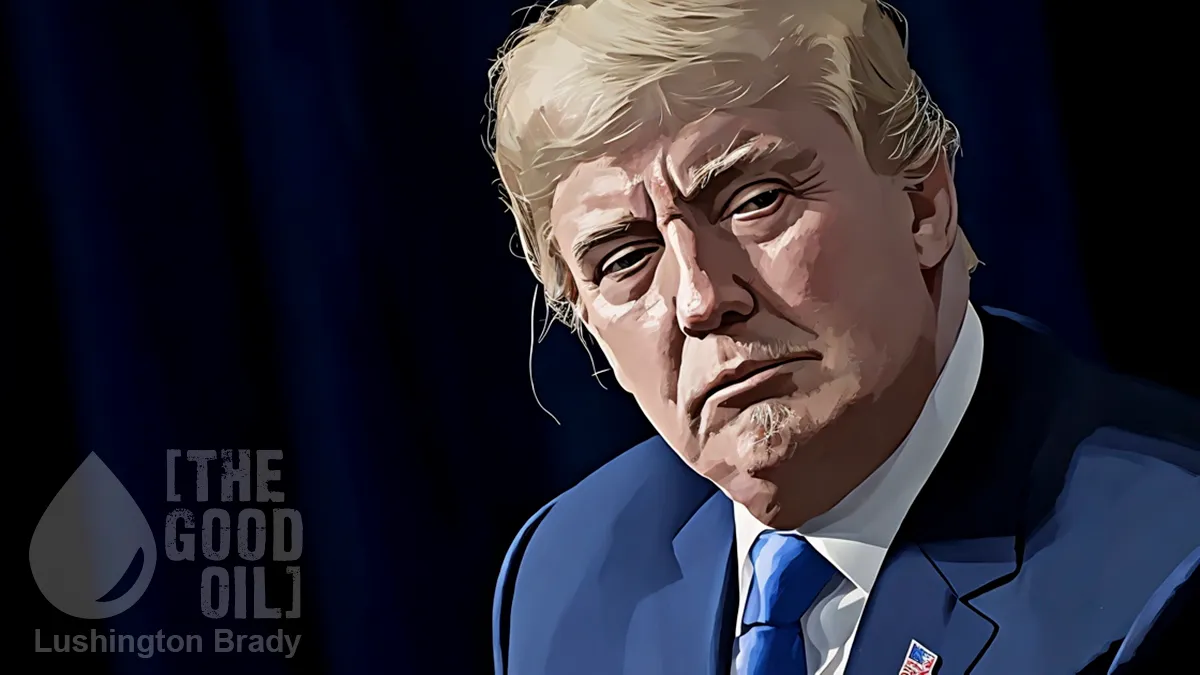Peter Williams
Writer and broadcaster for half a century. Now watching from the sidelines although verbalising thoughts on www.reality check.radio three days a week.
The markets are in meltdown, there’s a recession on the way and it’s all Donald Trump’s fault. His tariff regime is the stupidest and most nonsensical move in the history of modern economics.
That essentially sums up how the world has been reporting the turmoil of the last week since “Liberation Day” and its consequences were unleashed on the world.
Not untypically the reporting has been hopelessly biased. Is there anybody, anywhere who might be able to explain just what Donald Trump is trying to do by installing this ultra-protectionist trade regime into the US?
If you look hard enough the explanation is there and it’s worth considering. Two podcasts, one featuring Bob Lighthizer, Trump’s trade representative during his first term and the other with Treasury Secretary Scott Bessent, both in conversation with Tucker Carlson, put the theory of tariff protection in the foreground and explain why Trump is doing what he’s doing.
Lighthizer is especially good. He’s now 77, a lawyer who’s worked in trade negotiations on and off since the 1970s and was in Ronald Reagan’s administration as deputy trade representative in the 1980s.
He believes the system of international trade has failed.
You’re supposed to export in order to import, that means we both get the benefit of trade and we both get higher standards of living. But it’s now evolved to where we have a few countries, the US being the biggest, which have an open capital system and an open trading system and other countries have an industrial policy which is designed not to increase the standard of living of their citizens but to gain wealth (for companies and governments).
The United States last ran a trade surplus in 1975. It’s most recent trade deficit, the amount imported less the amount exported, was US1.15 trillion dollars.
China’s most recent trade surplus was US822 billion dollars.
According to Lighthizer no country should run trade deficits for long periods of time, yet the US has not had a surplus for half a century. That he says is a massive transfer of wealth from the US to other countries in return for American’s current level of consumption.
The former trade representative talks of a metric known as a country’s International Investment Position. That is the amount Americans own throughout the world compared to what the rest of the world owns in the US.
That number, he says, is negative US23 trillion dollars and it’s grown by US20 trillion dollars this century. So what’s happened is that Americans have allowed overseas entities into the country to issue debt to US entities, including the government, and have bought real estate and shares in US companies. In return Americans have had their iPhones made in China, their semi-conductors in Taiwan and their Nike sneakers in Vietnam.
The contrast he says is with the years after World War Two when Americans made things, sold them to the world and became rich. From 1960 to 1980 there were 14 years when GDP growth in the US was more than three per cent. From 1980 to 2000, there were a further 14 years of positive GDP growth. This century there have been just three years of GDP growth in excess of three per cent.
That he says, “coincides with this period of uber globalization, hyper free trade that came on stream in the late 1990s”.
But can Trump’s tariffs turn back the clock?
In 1971–72 I was an AFS high school student in upstate New York. I lived for a year in Corning, the eponymous hometown for the Fortune 500 company Corning Incorporated. It has a New York Stock Exchange capitalization of $US33.5 billion and makes, among many other products, Gorilla Glass – used in every smartphone on the planet.
Corning Inc keeps its headquarters in this small city but it manufactures at 77 sites in over 30 countries, mostly through Asia but also in Mexico and eastern Europe.
The company has been a significant innovator in numerous fields since being formed in 1870. Corning gave the world Pyrex and Corningware kitchen dishes. That division has now been sold and those brands are made in China.
Corning Inc is one of the world’s largest manufacturers of fibre-optic cable. Some is made in the US. Most is produced in Poland, China and India.
In the nearby suburb of Painted Post, the biggest employer in my time was Ingersoll Rand, known as IR. The company claimed to have the world’s largest air compressor manufacturing plant right there in our village. From the 1950s to the 1980s IR’s Painted Post usual regular workforce was over 2500.
The huge IR plant our school bus drove past each day closed in 1985. These days the remnants of the IR presence are at a factory owned by Siemens. It employs about 350 workers.
The Ingersoll Rand name lives on with one factory in North Carolina but most of its products are now made in China and India.
In 1950 the population of Corning, New York peaked officially at 17,684. Today it is 10,500.
Painted Post in 1950 had 2405 residents. By 2023 the population had dropped to 1729.
There were two high schools in this conurbation when I was there in 1971. Ten years ago they merged into one.
What has happened in Corning and Painted Post in the last half century has been replicated in thousands of towns and cities across the US.
As the New York state comptroller or chief financial officer wrote of the population decrease in his Economic and Fiscal Profile for Corning, New York:
This decline is consistent with a widespread decrease in manufacturing in the northeast and Midwest as many industries shifted production to the south or overseas and competition from foreign imports increased.
So do you see what Donald Trump is trying to achieve with his tariffs?
Up till the 1980s, the US was essentially a self-contained economy. It made stuff for itself and it consumed what it made.
Anybody who has lived for the last half century knows the reality of manufacturing across the world. When I bought my first ever Levi jeans at the JCPenney store in Corning in 1971, they were made in California.
Buy a pair of Levis today and they’ve been sewn up in either China, Bangladesh or Vietnam.
The America Donald Trump wants back is one where the middle class will once again have well-paid, quality-skilled and semi-skilled manufacturing jobs in their small- or medium-sized town or city making air compressors or jeans or Nike shoes, not to mention cars and semi-conductors.
Companies like Corning Inc and its biggest customer Apple will be forced to make their products inside the US border, otherwise the imported iPhone with its Gorilla Glass will be subject to a 54 per cent tariff as a good made in China. Yes it will take some time to fully revive US manufacturing but the demise of the middle class and the inability for them to make a decent livable income for the last 40 years is one of the biggest stains on US life.
The gap between rich and poor has become an ever-widening chasm. US Treasury Secretary Scott Bessant told Tucker Carlson last week that in the (northern) summer of 2024 more Americans than ever took a holiday in Europe.
During that same time more Americans than ever needed to go to a charity food bank to top up the weekly grocery purchase.
States like Pennsylvania and Michigan and northern Indiana are called the Rust Belt. The once thriving steel and car industries in cities like Detroit, Pittsburgh and Gary are gone, gone to graveyards in Shanghai and Shenzhen.
Not for much longer if Donald Trump has his way. Yes the short term will be brutal. But then the most effective economic action is often quick and brutal. It happened here in 1985 as we removed our protectionist barriers so we could trade more easily with the world. It wrecked our manufacturing industries too. But our economy will always be too small to support the making of cars and TVs and fridges without massive government subsidy.
The US is different. They’re an economy that can feed and make things for itself. What Donald Trump has done should be no surprise. He signaled his intentions years ago. In his first term the tariffs on Chinese-made goods pushed up the cost of them to US consumers by just an estimated 0.7 per cent, according to Scott Bessent.
The inflationary impact inside the US of these widespread tariffs may not be as severe as most economists predict.
Trump has made a bold, history-making move. But the treasury secretary believes a combination of DOGE cost cutting and increased incomes, meaning more tax being paid, will stifle the income from tariffs very quickly.
Yes it will be a protected and closed economy but that’s what America First means. The US has been exporting its wealth to the world since the 1980s. Now it wants it back.
This article was originally published on the author’s Substack.








